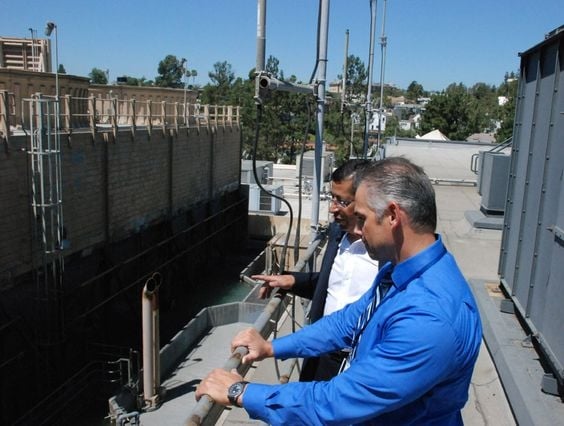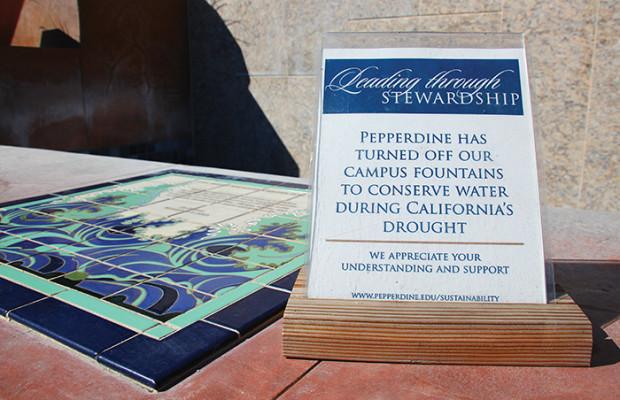You have /5 articles left.
Sign up for a free account or log in.

UCLA Energy Services Director Lewis Rosman and professor Yoram Cohen look over the congregation plant cooling towers where a smart water filtration system was piloted
UCLA
Some of California’s most recognizable college campuses are sunny, lush places all year round, brimming with palm trees, green grass and dozens of fountains.
But that image may be a thing of the past, as campuses across the state are adopting water action plans that include converting landscaping to drought-friendly plants.
Landscape changes are one of a myriad of steps colleges in the state are taking to reduce their water consumption as California falls deeper into a historic drought.
Many colleges in the state drafted their drought action plans in early 2014, after the University of California and California State University System -- which together serve more than 680,000 students -- announced goals to reduce water consumption by 20 percent by 2020.
A year later, the pressure has ratcheted up after a low snowpack increased water concerns and led to mandatory restrictions. Earlier this month, Governor Jerry Brown, a Democrat, ordered cities and towns to cut water usage by 25 percent over the next year.
That means many universities’ plans are already inadequate to meet state goals and need to be revised to reflect the increased severity, said Boykin Witherspoon III, director of programs for the Water Resources Institute at California State University at San Bernardino.
Landscaping is the primary focus of many colleges’ drought action plans, and for good reason. Aside from water used for agriculture, about 50 percent of the state’s drinkable water is used on landscaping, Witherspoon said.
Unfortunately, the 23 CSU campuses have hundreds of acres of grassy lawns that require a lot of water to stay green. It costs about $5 per square foot to convert turf into low-water-consumption landscape. One acre equals 43,560 square feet, meaning the cost of converting a single campus would top tens of millions of dollars.
“There’s just no practical way to fund that activity,” Witherspoon said.
But there are what Witherspoon calls best management practices. If a campus has a scheduled construction project that would already disturb the turf, then grass should be replaced with drought-resistant plants.
California State University at Long Beach started a small landscape conversion project last week. Two acres of grass will be replaced with plants that can survive with little water. Over all, the university uses just under 200 million gallons of water each year, enough to fill almost 300 Olympic-size swimming pools, according to the university's water action plan. Landscape, including athletic field maintenance, accounts for between 40 and 50 percent of water consumption at Long Beach, said Michael Uhlenkamp, executive director of news and digital media.
In addition to landscaping, the university spent about $200,000 last summer to install low-flow urinals, showerheads and faucets in its residence halls, Uhlenkamp said. Most of the cost will be made up by rebates from the university’s water provider.
Residence halls at Long Beach use about 45.5 million gallons of water a year -- about a quarter of total consumption -- and the upgrades are expected to reduce usage by 3.5 million gallons a year.
The CSU System’s Water Resources and Policy Initiatives group is leveraging the expertise of Cal State faculty members to work on education, research and policy recommendations for water solutions. One of the group's focuses right now is figuring out how the 23-campus system can most effectively reduce its baseline consumption.
One task will be to perform evapotranspiration on each campus to determine how much water a campus actually needs to use on its landscape based on climate and foliage type, Witherspoon said.
But one challenge of establishing a systemwide plan is that some colleges have had proactive water conservation initiatives for several years, Witherspoon said. Some campuses likely have already reduced their consumption by 25 percent in the past decade, and it’s tougher to improve on a high sustainability level.
“If it took 20 percent of their energy to get to where they are today, it will be burden for them [to continue decreasing their usage],” he said. “The easy things you can do, they’ve already done.”
One such example, although not in the CSU System, is Pepperdine University, which has said that it will be difficult to reduce its consumption another 25 percent. Water conservation and sustainability has been a priority on the Malibu campus for several years, spokeswoman Tiffany Wright said. Almost all the drinkable water on campus is reused, and the university uses recycled water treated at its wastewater facility for irrigation. Last year, the university shut off water to all its decorative fountains.
The University of California at Los Angeles is finishing up one of its largest water-related projects, a new filtration system that's estimated to save 17.3 million gallons a year. The enhanced water-cleaning system was created a few years ago by professors at the UCLA Water Technology Research Center, so it advanced not only research but also institutional goals to reduce water consumption, Chief Sustainability Officer Nurit Katz said.
In terms of student behavior, housing services at UCLA is hosting a campaign to encourage students to recoup the 20 million gallons of water that were lost during a massive flood in August. The sustainability office has urged its 15,000 on-campus residents to reduce their consumption in some familiar ways, such as shorter showers and turning off the water while brushing their teeth. Others are more specific to campus lifestyle -- ditching the tray to carry food in the dining hall, for example, can save up to half a gallon of water per tray, according to the office’s website.
Student participation in conservation efforts could be an important boost, because administrators pay attention to issues that students are passionate about, Witherspoon said.
Shawn Rhoads, a senior at the University of Southern California, agrees. He’s executive director of the Environmental Sustainability Assembly and the undergraduate representative to a Water Conservation Task Force that was created last year. The formation of the task force was a little late, given that it came after three consecutive years of drought, Rhoads said.
But now the group is considering several common steps, such as auditing the water used in buildings and investing in drought-friendly landscaping.
“With the new restriction in California, I think we should start moving forward with a lot more momentum,” he said.
Students can help in that regard, Rhoads said. They have the largest voice on campus and they can bring energy to the task force’s goals by showing administrators that water conservation is a cause they’re invested in.
Rhoads suggested college sustainability groups host more projects to educate students and get them involved. In Los Angeles, for example, students at USC and UCLA used their annual rivalry week in the fall to compete over which campus could recruit more students to pledge to conserve water.
Water conservation is a small aspect of campus sustainability efforts promoted by the Association for the Advancement of Sustainability in Higher Education. In 2014, though, drought response took a more central role in California, based on data collected for AASHE’s 2014 Higher Education Sustainability Review, which will be released next week.
The report will highlight one university, the University of California at Santa Cruz, where students are playing an important role in water conservation. There, a five-member student Drought Response Team inspects buildings for water leaks and audits how much water is being used, while promoting conservation to fellow students.
This article has been updated to correct the name of the Environmental Student Assembly at the University of Southern California.




